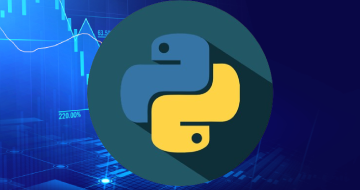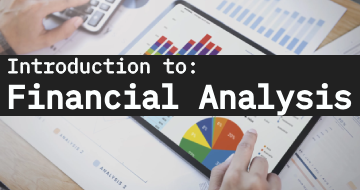IIRF Online > Finance & Accounting > Finance > Financial Analysis > Python for Finance: Investment Fundamentals & Data Analytics
Python for Finance: Investment Fundamentals & Data Analytics by Udemy
Learn Python Programming and Conduct Real-World Financial Analysis in Python - Complete Python Training
Course Highlights
- Learn how to code in Python
- Take your career to the next level
- Work with Python’s conditional statements, functions, sequences, and loops
- Work with scientific packages, like NumPy
- Understand how to use the data analysis toolkit, Pandas
- Plot graphs with Matplotlib
- Use Python to solve real-world tasks
- Get a job as a data scientist with Python
- Acquire solid financial acumen
- Carry out in-depth investment analysis
- Build investment portfolios
- Calculate risk and return of individual securities
- Calculate risk and return of investment portfolios
- Apply best practices when working with financial data
- Use univariate and multivariate regression analysis
- Understand the Capital Asset Pricing Model
- Compare securities in terms of their Sharpe ratio
- Perform Monte Carlo simulations
- Learn how to price options by applying the Black Scholes formula
- Be comfortable applying for a developer job in a financial institution
Skills you will learn!
Curriculum
2 Topics
What Does the Course Cover?
Download Useful Resources - Exercises and Solutions
11 Topics
Programming Explained in 5 Minutes
Programming Explained in 5 Minutes
Why Python?
Why Python?
Why Jupyter?
Why Jupyter?
Installing Python and Jupyter
Jupyter’s Interface – the Dashboard
Jupyter’s Interface – Prerequisites for Coding
Jupyter’s Interface
Python 2 vs Python 3: What's the Difference?
20 Topics
Variables
Variables - Exercise #1
Variables - Exercise #2
Variables - Exercise #3
Variables - Exercise #4
Variables
Numbers and Boolean Values
Numbers and Boolean - Exercise #1
Numbers and Boolean - Exercise #2
Numbers and Boolean - Exercise #3
Numbers and Boolean - Exercise #4
Numbers and Boolean - Exercise #5
Numbers and Boolean Values
Strings
Strings - Exercise #1
Strings - Exercise #2
Strings - Exercise #3
Strings - Exercise #4
Strings - Exercise #5
Strings
30 Topics
Arithmetic Operators
Arithmetic Operators - Exercise #1
Arithmetic Operators - Exercise #2
Arithmetic Operators - Exercise #3
Arithmetic Operators - Exercise #4
Arithmetic Operators - Exercise #5
Arithmetic Operators - Exercise #6
Arithmetic Operators - Exercise #7
Arithmetic Operators - Exercise #8
Arithmetic Operators
The Double Equality Sign
The Double Equality Sign - Exercise #1
The Double Equality Sign
Reassign Values
Reassign Values - Exercise #1
Reassign Values - Exercise #2
Reassign Values - Exercise #3
Reassign Values - Exercise #4
Reassign values
Add Comments
Add Comments
Line Continuation
Line Continuation - Exercise #1
Indexing Elements
Indexing Elements - Exercise #1
Indexing Elements - Exercise #2
Indexing Elements
Structure Your Code with Indentation
Structure Your Code with Indentation - Exercise #1
Structure Your Code with Indentation
14 Topics
Comparison Operators
Comparison Operators - Exercise #1
Comparison Operators - Exercise #2
Comparison Operators - Exercise #3
Comparison Operators - Exercise #4
Comparison Operators
Logical and Identity Operators
Logical and Identity Operators - Exercise #1
Logical and Identity Operators - Exercise #2
Logical and Identity Operators - Exercise #3
Logical and Identity Operators - Exercise #4
Logical and Identity Operators - Exercise #5
Logical and Identity Operators - Exercise #6
Logical and Identity Operators
11 Topics
Introduction to the IF statement
IF - Exercise #1
IF - Exercise #2
Introduction to the IF statement
Add an ELSE statement
ELSE - Exercise #1
Else if for Brief – ELIF
ELIF Exercise #1
ELIF Exercise #2
A Note on Boolean Values
A Note on Boolean Values
23 Topics
Defining a Function in Python
Creating a Function with a Parameter
Creating a Function - Exercise #1
Creating a Function - Exercise #2
Another Way to Define a Function
Another Way to Define a Function - Exercise #1
Another Way to Define a Function
Using a Function in another Function
Using a Function in another Function - Exercise #1
Combining Conditional Statements and Functions
Combining Conditional Statements and Functions - Exercise #1
Creating Functions Containing a Few Arguments
Notable Built-in Functions in Python
Notable Built-in Functions in Python - Exercise #1
Notable Built-in Functions in Python - Exercise #2
Notable Built-in Functions in Python - Exercise #3
Notable Built-in Functions in Python - Exercise #4
Notable Built-in Functions in Python - Exercise #5
Notable Built-in Functions in Python - Exercise #6
Notable Built-in Functions in Python - Exercise #7
Notable Built-in Functions in Python - Exercise #8
Notable Built-in Functions in Python - Exercise #9
Functions
34 Topics
Lists
Lists - Exercise #1
Lists - Exercise #2
Lists - Exercise #3
Lists - Exercise #4
Lists - Exercise #5
Lists
Using Methods
Using Methods - Exercise #1
Using Methods - Exercise #2
Using Methods - Exercise #3
Using Methods - Exercise #4
Using Methods
List Slicing
List Slicing - Exercise #1
List Slicing - Exercise #2
List Slicing - Exercise #3
List Slicing - Exercise #4
List Slicing - Exercise #5
List Slicing - Exercise #6
List Slicing - Exercise #7
Tuples
Tuples - Exercise #1
Tuples - Exercise #2
Tuples - Exercise #3
Tuples - Exercise #4
Dictionaries
Dictionaries - Exercise #1
Dictionaries - Exercise #2
Dictionaries - Exercise #3
Dictionaries - Exercise #4
Dictionaries - Exercise #5
Dictionaries - Exercise #6
Dictionaries
20 Topics
For Loops
For Loops - Exercise #1
For Loops - Exercise #2
For Loops
While Loops and Incrementing
While Loops and Incrementing - Exercise #1
Create Lists with the range() Function
Create Lists with the range() Function - Exercise #1
Create Lists with the range() Function - Exercise #2
Create Lists with the range() Function - Exercise #3
Create Lists with the range() Function
Use Conditional Statements and Loops Together
Use Conditional Statements and Loops Together - Exercise #1
Use Conditional Statements and Loops Together - Exercise #2
Use Conditional Statements and Loops Together - Exercise #3
All In – Conditional Statements Functions and Loops
Conditional Statements Functions and Loops - Exercise #1
Iterating over Dictionaries
Iterating over Dictionaries - Exercise #1
Iterating over Dictionaries - Exercise #2
21 Topics
Object Oriented Programming
Object Oriented Programming - Quiz
Modules and Packages
Modules - Quiz
The Standard Library
The Standard Library - Quiz
Importing Modules
Importing Modules - Quiz
Must-have packages for Finance and Data Science
Must-have packages - Quiz
Working with arrays
Generating Random Numbers
A Note on Using Financial Data in Python
Sources of Financial Data
Accessing the Notebook Files
Importing and Organizing Data in Python – part I
Importing and Organizing Data in Python – part II.A
Importing and Organizing Data in Python – part II.B
Importing and Organizing Data in Python – part III
Changing the Index of Your Time-Series Data
Restarting the Jupyter Kernel
14 Topics
Considering both risk and return
Risk and return - Quiz
What are we going to see next?
Calculating a security's rate of return
Calculating a security's rate of return
Calculating a Security’s Rate of Return in Python – Simple Returns – Part I
Calculating a Security’s Rate of Return in Python – Simple Returns – Part II
Calculating a Security’s Return in Python – Logarithmic Returns
What is a portfolio of securities and how to calculate its rate of return
What is a portfolio of securities and how to calculate its rate of return - Quiz
Calculating a Portfolio of Securities' Rate of Return
Popular stock indices that can help us understand financial markets
Which of the following is not an index? - Quiz
Calculating the Indices' Rate of Return
15 Topics
How do we measure a security's risk?
Which of the following sentences is true? - Quiz
Calculating a Security’s Risk in Python
The benefits of portfolio diversification
Investing in stocks - Quiz
Calculating the covariance between securities
Covariance - Quiz
Measuring the correlation between stocks
Correlation - Quiz
Calculating Covariance and Correlation
Considering the risk of multiple securities in a portfolio
Calculating Portfolio Risk
Understanding Systematic vs. Idiosyncratic risk
Diversifiable Risk - Quiz
Calculating Diversifiable and Non-Diversifiable Risk of a Portfolio
6 Topics
The fundamentals of simple regression analysis
Regressions - Quiz
Running a Regression in Python
Are all regressions created equal? Learning how to distinguish good regressions
Regressions - Quiz
Computing Alpha Beta and R Squared in Python
5 Topics
Markowitz Portfolio Theory - One of the main pillars of modern Finance
Markowitz - Quiz
Obtaining the Efficient Frontier in Python – Part I
Obtaining the Efficient Frontier in Python – Part II
Obtaining the Efficient Frontier in Python – Part III
13 Topics
The intuition behind the Capital Asset Pricing Model (CAPM)
CAPM - Quiz
Understanding and calculating a security's Beta
Beta - Quiz
Calculating the Beta of a Stock
The CAPM formula
CAPM - Quiz
Calculating the Expected Return of a Stock (CAPM)
Introducing the Sharpe ratio and how to put it into practice
Sharpe ratios - Quiz
Obtaining the Sharpe ratio in Python
Measuring alpha and verifying how good (or bad) a portfolio manager is doing
Alpha - Quiz
3 Topics
Multivariate regression analysis - a valuable tool for finance practitioners
Multivariate Regressions - Quiz
Running a multivariate regression in Python
18 Topics
The essence of Monte Carlo simulations
Monte Carlo - Quiz
Monte Carlo applied in a Corporate Finance context
Monte Carlo in Corporate Finance - Quiz
Monte Carlo: Predicting Gross Profit – Part I
Monte Carlo: Predicting Gross Profit – Part II
Forecasting Stock Prices with a Monte Carlo Simulation
Monte Carlo Simulations - Quiz
Monte Carlo: Forecasting Stock Prices - Part I
Monte Carlo: Forecasting Stock Prices - Part II
Monte Carlo: Forecasting Stock Prices - Part III
An Introduction to Derivative Contracts
Derivatives - Quiz
The Black Scholes Formula for Option Pricing
Monte Carlo: Black-Scholes-Merton
Using Monte Carlo with Black-Scholes-Merton - Quiz
Monte Carlo: Euler Discretization - Part I
Monte Carlo: Euler Discretization - Part II
32 Topics
pandas Series - Introduction
A Note on Completing the Upcoming Coding Exercises
pandas Series - Exercise #1
pandas Series - Exercise #2
pandas Series - Exercise #3
pandas Series - Exercise #4
pandas Series - Exercise #5
pandas Series - Exercise #6
pandas Series - Exercise #7
pandas Series - Exercise #8
pandas Series - Exercise #9
pandas Series - Exercise #10
pandas - Working with Methods - Part I
pandas - Working with Methods - Part II
pandas - Working with Methods - Exercise #1
pandas - Working with Methods - Exercise #2
pandas - Using Parameters and Arguments
pandas - Using Parameters and Arguments - Exercise #1
pandas - Using Parameters and Arguments - Exercise #2
pandas Series - .unique() and .nunique()
pandas Series - .sort_values()
pandas DataFrames - Introduction - Part I
pandas DataFrames - Introduction - Exercise #1
pandas DataFrames - Introduction - Exercise #2
pandas DataFrames - Introduction - Part II
pandas DataFrames - Introduction - Exercise #3
pandas DataFrames - Introduction - Exercise #4
pandas DataFrames - Introduction - Exercise #5
pandas DataFrames - Common Attributes
pandas DataFrames - Data Selection
pandas DataFrames - Data Selection with .iloc[]
pandas DataFrames - Data Selection with .loc[]
10 Topics
Technical Analysis - Principles Applications Assumptions
Charts Used in Technical Analysis
Other Tools Used in Technical Analysis
Trend Support and Resistance Lines
Common Chart Patterns
Price Indicators
Momentum Oscillators
Non-price Based Indicators
Technical Analysis - Cycles
Intermarket Analysis
1 Topic
Bonus Lecture: Next Steps

Python for Finance: Investment Fundamentals & Data Analytics











